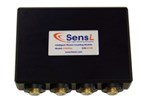SensL Heralds A New Era In Intelligent Photon Counting

Cork, Ireland - SensL, a provider of innovative low light detection modules for applications ranging from health diagnostics, medical analysis, bio-medical sensing to astronomy, lidar and environmental protection, today announced the introduction of the "PCMPlusX" USB photon detection platform.

The PCMPlusX is a derivative of its highly successful predecessor, the PCMPlus, and features USB 2.0 compatibility, 2.5ns time binning (with on-board microprocessor and memory), data correlation and photon counting algorithms. The platform is currently available with up to 4 sensing channels with a maximum of 16 available on request. This results in significant space savings and efficiencies for OEM customers who require multiple sensors in their equipment.
"The PCMPlusX facilitates the integration of detectors, lasers and signal processing for OEMs," commented Dr Carl Jackson, SensL's Chief Technical Officer. "The modular system design and reconfigurable input/output port allows time binning, time tagging and correlation between signals - with the PCMPlusX at the heart of the system. The necessary driver libraries to support this integration with user applications are also available"
The PCMPlusX is controlled through a modular, Java based, USB interface designed to enable the user to easily configure and manage the multiple sensors within the PCMPlusX module as well as control multiple PCMPlusX modules. A graphical interface not only allows each sensor to be individually optimized but also displays the photon count rate through customised graphical display and analytical tools.
"By marrying the USB PCMPlusX platform with a highly sophisticated software control system, we are the first to bring to market such a user friendly and feature rich photon counting solution," added Joe O'Keeffe, SensL's Chief Commercial Officer. "With the resulting unprecedented levels of flexibility, it is now no longer necessary to be an expert in optics and electronics to successfully implement photon counting in your original equipment, process monitoring or R&D lab applications."
The system is in full production release.
SOURCE: SensL
